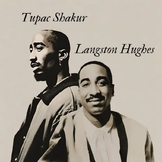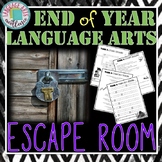40 results
8th grade chemistry pdfs for Montessori
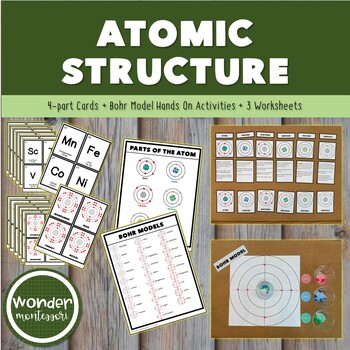
Atomic Structure Montessori Cards, Bohr Model, and Activities
Atomic Structure Montessori Cards, Bohr Model, and ActivitiesLooking for a great way to bring together art and ELA in your classroom? This DIY postcard set is a quick and easy eay to accomplish that. Just print, cut, and go!This download includes a huge assortment of activities for Upper Elementary aged students. These can be done as lessons, or students may work through on their own or in small groups.- 4-part cards address parts of an atom: proton, neutron, electron, nucleus, orbital, and a
Subjects:
Grades:
4th - 8th
Types:

Molecule model 3 part cards
Montessori 3 part cards to support the universe curriculum i.e Bohr's board.
Subjects:
Grades:
2nd - 8th
Types:
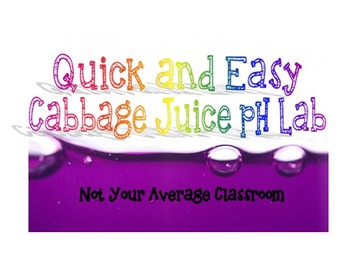
Quick and Easy Cabbage Juice pH Indicator Lab
This activity results in impressive color changes and is really fun to do! Students will use cabbage juice to test various substances for acidity or alkalinity. Purple cabbage juice turns bright pink for acids and bright blue for bases. This lab lists vinegar, tap water, baking soda solution, lemon/lime soda, and bleach solution - but you can easily convert the file to a word document and edit as needed.
This is a completely qualitative lab, and it is meant to be done in very little time. The ac
Subjects:
Grades:
5th - 12th
Types:

Hands-on Interactive Volcano Bundle Study: Types, Formation and Famous Volcanos
Create a science experiment of a real "erupting" volcano with a 3D model and step by step instructions. Learn about how volcanos form with a illustrated poster and learn about volcanos around the world with full color cards.*Photos may include completed items or display items not included. Please note this is ONLY for the digital copies of the resources used.
Subjects:
Grades:
PreK - 8th
Types:
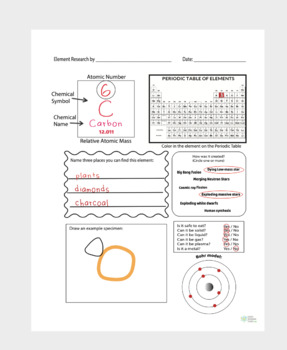
Element Research Portfolio
Everything your students need to make research portfolios all about the elements. Includes a cover page to decorate and a double-sided worksheet to guide research (I listed our favorite books and free websites) as well as a periodic table that shows where the elements come from to make completion simple and straight-forward. Use the included blue-lined, Montessori style paper to write favorite facts (or use your own paper style if preferred). Makes for wonderful student-lead learning & Mont
Subjects:
Grades:
1st - 9th
Types:
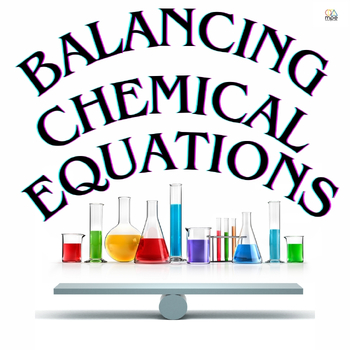
Balancing Chemical Equations
Introduction: Balancing chemical equations is a crucial skill in chemistry that involves adjusting the coefficients of reactants and products in a chemical equation to ensure that the number of atoms of each element on both sides of the equation is equal. This process is essential in understanding chemical reactions and predicting the outcome of a reaction. Balancing chemical equations is also helpful in real-life scenarios, such as industrial processes involving chemical reactions or environmen
Subjects:
Grades:
5th - 8th
Types:

LAB Chemistry Density of Pennies - with Graphing & Demos
Engage your chemistry students by having them determine the composition of pennies as it changed over time. Students will chart & graph their results. After, you can demonstrate and prove that pennies are made of zinc internally.Included:3 page Student worksheet with procedure, chart, graph & analysis questions1 page teacher density demonstrations (5 easy options)Materials: pennies 13 pre 1982 & 13 post 1982 (per group or 1 set every two groups & switch pennies)graduated cylinder
Subjects:
Grades:
4th - 12th, Higher Education
Types:
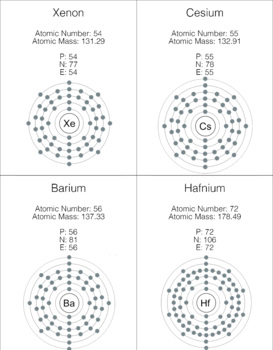
Elements of the Periodic Table Electron Orbitals
Element cards with electron orbitals, number of protons, neutrons, and electrons, name of elements, and element symbol. Use these cards to further explore atoms, subatomic particles, and elements of the periodic table.These are not three part cards, but can easily be made into three part cards by cutting the name off the top.
Subjects:
Grades:
1st - 10th
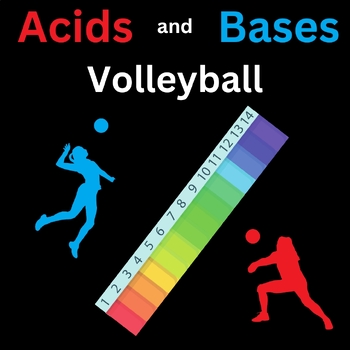
Acids and Bases Volleyball
What makes something acidic or basic? It all comes down to hydrogen. When we measure the acidity of alkalinity, we use the pH scale, which literally stands for the "potential of hydrogen." When we dissolve acids in water, we create excess hydrogen ions that are positively charged (H+). These hydrogen ions bind to water (H2O) to create hydronium (H3O+). The more hydronium present in the solution, the more acidic it is. Conversely, when we dissolve bases in water, we create excess negatively char
Subjects:
Grades:
5th - 8th
Types:

Advanced Bohr Model Printable
Children can use this printable Bohr Atomic Model to build atoms and strengthen their understanding of the elements.*This is a more advanced version of the Bohr Model that can be used to build atoms of elements with an atomic number greater than 20.*Children will need to do research on the correct number of electrons to place in each shell.*For an introduction to using the Bohr Model, please check out my other resource Beginner Bohr Model + Element Cards on Teacher’s Pay Teachers*You will need t
Subjects:
Grades:
4th - 8th
Also included in: Bohr Model Bundle: Beginner and Advanced Models
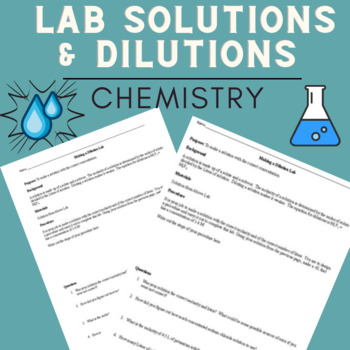
LAB - Chemistry - Make a Solution & Dilution - Easy Materials! - With KEY
This lab has students write their own procedure to make a solution and dilution with teacher observation & testing. This inquiry-STEM activity is great to get students thinking and engaged. Even some of the smartest students fail to connect Molarity to physical performance. This lab allows for that connection.I usually use a pH strip to test their solutions and dilutions! pH probe is better as well.materials:solute - the KEY is with citric acid, but any can be used.BalanceGraduated Cylinderb
Subjects:
Grades:
8th - 11th
Types:

Parts of a Plant Cell 3 Part Cards Montessori Nomenclature Botany
Montessori's Classified Cards are well-known and loved because they are a great way to help your child learn to read. This resource is included in Zoology Unit 1: Basic Introduction to Living Organisms - click here for that resource.⭐⭐⭐3-Part Cards Parts of a Plant Cell Montessori⭐⭐⭐Save yourself hours of work. All you have to do is download the PDF, cut out the cards and labels, and you are all ready to go! The following is included:16 pictures with labels in type font (approximately 3½ x 3¼) 1
Grades:
1st - 9th
NGSS:
MS-LS1-2
Also included in: Living Nonliving Bundle eLearning and Printables Montessori Zoology

LAB Chemistry - Equilibrium Le Chatlier's Principle
Engage your chemistry students by having them performing an equilibrium shift. This lab is empowering because students can SEE the shift right before their eyes. This lab does require quite a bit of set up, but is well worth the effort.Included:1 sheet Lab 2 pagesObjective: Observe and determine the equilibrium shift of the reactionMaterials test tube tongs droppers0.1 M &g Iron (III) Nitrate 0.1 M KSCN 0.1 M NaOH 0.1 M Silver Nitrate 0.5 g KClWater 7 Test Tubes Test Tube Rack Stirring Ro
Subjects:
Grades:
8th - 12th, Higher Education
Types:
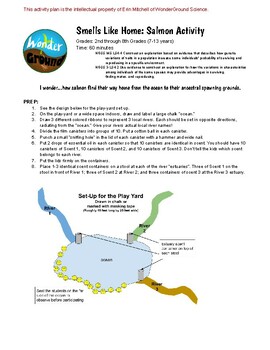
Salmon: Smells Like Home
Another engaging activity by WonderGround Science! In this activity, students will become anadromous fish, navigating their way to their ancestral spawning grounds. The activity includes 7 deep-thinking questions for students to discuss, regarding water quality, turbidity, and other factors that might hinder chemical cues that salmon use to navigate. Materials are found in a typical classroom.
Subjects:
Grades:
2nd - 8th
Types:
NGSS:
3-LS4-3
, 3-LS4-2
, 3-LS4-4
, MS-LS4-4
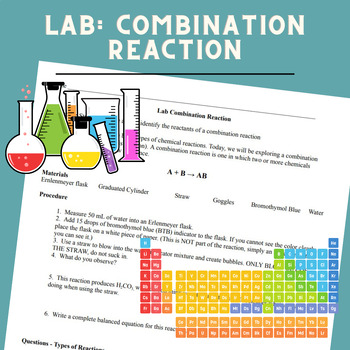
LAB Chemistry - Easy Combination Reaction
Engage your chemistry students by having them perform a quick combination reaction, with a fun color change. This gets students up and moving with easy setup & safety measures. They will write out a full equation for the reaction observed (problem solving) as well as a quick balancing practice.Objective: Observe and predict the reactants of a combination reactionMaterials:Erlenmeyer flaskGraduated CylinderStrawBTB (bromothymol blue) Water
Subjects:
Grades:
7th - 12th, Higher Education
Types:
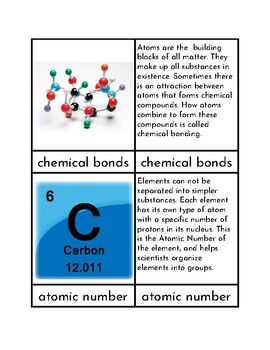
Chemical Bonds - Three/Four Part Cards
This PDF can be used to create a set of three or four part cards to teach children about basic Chemical Bonds. There is a picture card, word card, a picture and word card (control), and description card for each of the following terms: chemical bonds, atomic number, electron shells, outer shells, valence electrons, covalent bonds, and ionic bonds. Be sure to check out my FREEBIE: Parts of an Atom - Three/Four Part Cards!! Cards should be printed onto card stock, cut, and laminated.
Subjects:
Grades:
3rd - 8th
Types:
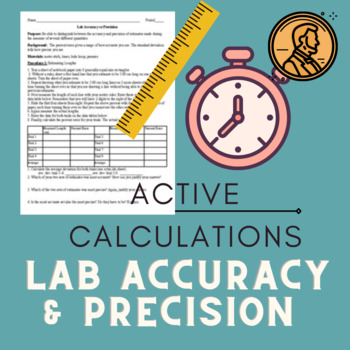
LAB Accuracy and Precision - Kinesthetic, Engaging, and Calculation Practice
Time: 50 minutesMaterials: Rulers, timers/stopwatches/computer for stopwatch, Pennies, & A target (hula hoop, tape on the floor)
Subjects:
Grades:
8th - 11th
Types:
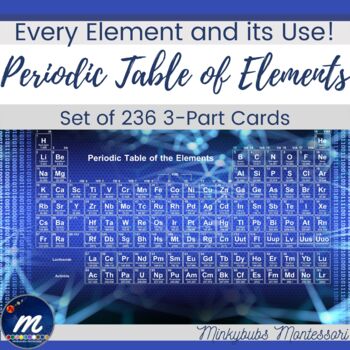
Periodic Table of Elements 3-Part Cards with Common Uses
The Periodic Table of Elements and Common Places they are found cards are an awesome and hands-on way for children to explore the various types of metals, and nonmetals of the 118 elements of the periodic table. Each of the 118 elements has a 3-part card of the element itself and a 3-part card of the place it can be found. Gorgeous high-quality photos on every element card invite the child to explore the element in details. There are 244 pages in this resource - save yourself hours.Each of the 1
Subjects:
Grades:
4th - 8th
NGSS:
HS-PS1-1
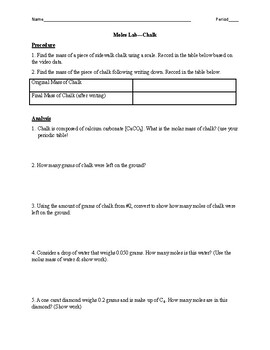
LAB Chemistry - Moles in My Name & Body!
Engage your chemistry students by having them calculate the amount of moles in their name by writing outside with sidewalk chalk, then calculate how many moles are in their own bodies! An easy twist on a classic lab.Included:Lab Worksheet 2 pagesObjective: Calculate the amount of moles in your name & bodyMaterials:scales/balancesSidewalk Chalk (or normal)This activity can be adjusted to play outside or also to write their name onto a piece of paper,
Subjects:
Grades:
8th - 12th, Higher Education
Types:
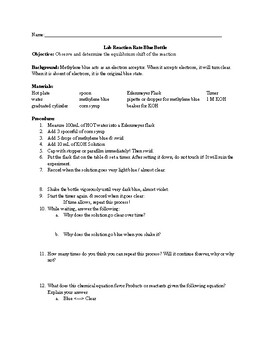
LAB Chemistry - Equilibrium Reaction Rates, Le Chatlier, Equilibrium Constant
Engage your chemistry students by having them performing an equilibrium shift. This lab is empowering because students can SEE the shift right before their eyes. This lab is quick and EASY to set up & the students enjoy the continuous changes. Teacher Note: Every shake adds oxygen back into the reaction!Included:1 sheet Lab 2 pagesObjective: Observe and determine the equilibrium shift of the reactionMaterials Hot plate spoon Erlenmeyer Flask Timerwater methylene blue pipette or drop
Subjects:
Grades:
8th - 12th, Higher Education
Types:

Science - Montessori Record Keeping
You can keep track of the child's progress in the area of science by using this Science Montessori Record Keeping.
Subjects:
Grades:
4th - 8th
Types:
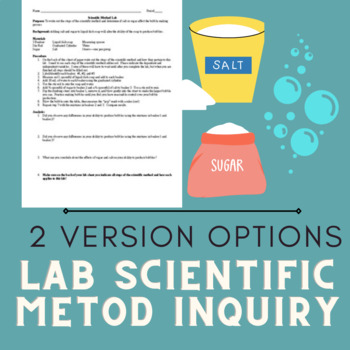
LAB Scientific Method Inquiry, Bubble Blowing - Engaging - 2 Different Versions!
This lab has students investigate what can form the biggest bubble using the scientific method - sugar or salt with regular water as a control. This can be edited to use any ingredients students wish to test as well! Simple and quick lab that has students thinking.Two Versions:1: Directions Provided 2: Design Your Own Experiment. I usually have a discussion on how to measure the bubbles and let the kids decide. (Blow the bubble on a table or paper & measure the pop!)Time: 45 minutesMaterials
Subjects:
Grades:
3rd - 12th
Types:
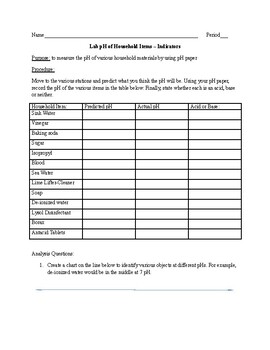
LAB - Chemistry - pH of Common Items - Acids and Bases
This lab has students determine the pH using pH paper of various household items. Anything you want can be substituted!materials:Sink WaterVinegarBaking sodaSugarIsopropylBloodSea WaterLime Lifter-CleanerSoapDe-ionized waterLysol DisinfectantBoraxAntacid Tablets
Subjects:
Grades:
5th - 11th
Types:

LAB Chemistry - Single Replacement VS Double Replacement with Practice Problems
Engage your chemistry students by having them perform two quick reactions, with a fun color change. They will write out a full equation for the reaction observed (problem solving) as well as a quick recap of the 2 types of chemical reactions. Included:1 sheet Lab1 sheet 13 balancing & identifying reactions problemsObjective: Observe and predict the reactants of a single and double replacement reactionMaterials:BeakersDroppersGraduated CylindersMagnesiumHydrochloric AcidPotassium IodideLead (
Subjects:
Grades:
8th - 12th, Higher Education
Types:
Showing 1-24 of 40 results





